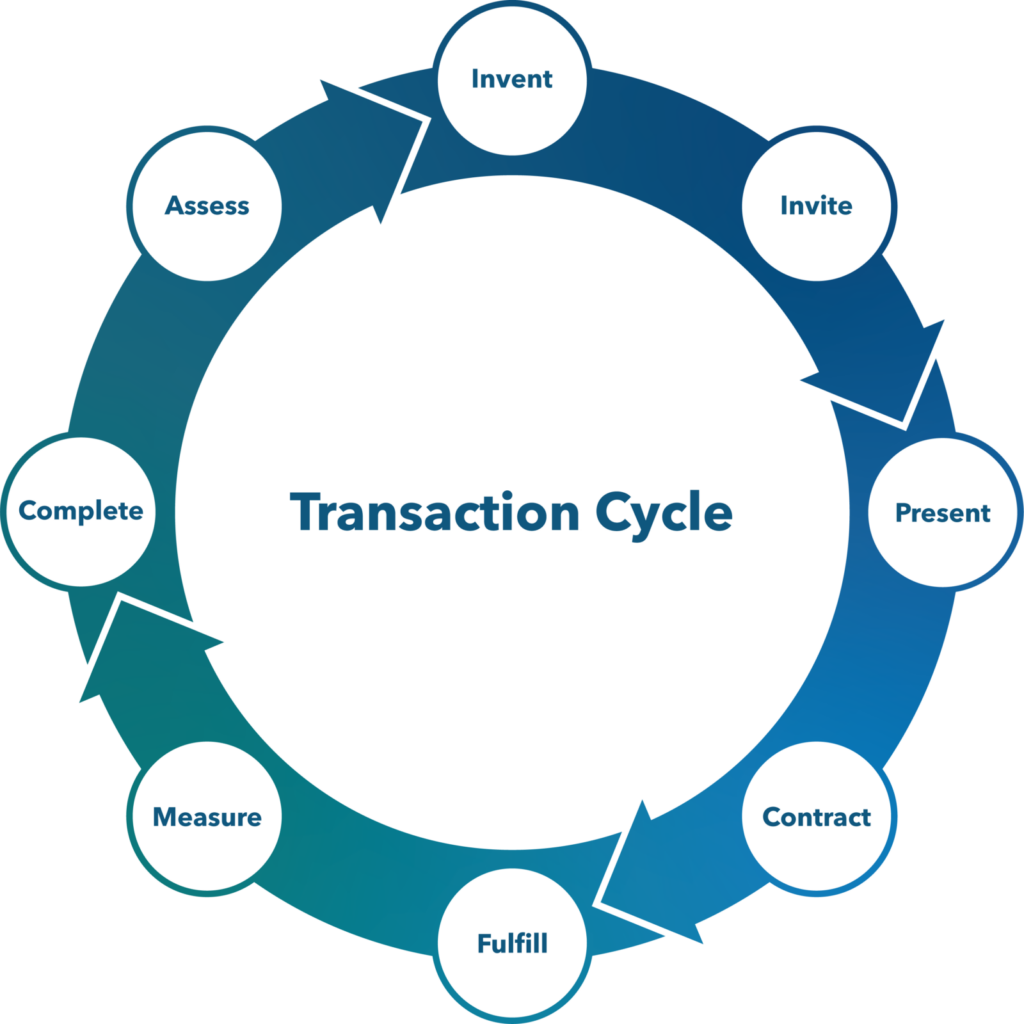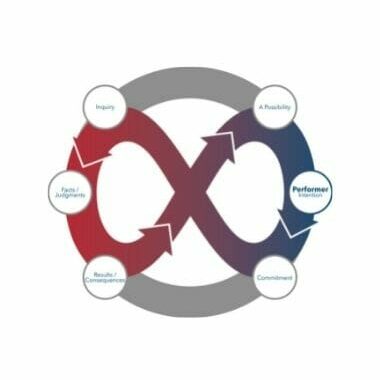If asked to draw a transaction, you'll likely sketch two stick figures shaking hands while exchanging money for something. Your abridged interpretation may be the root of all your problems; it's why you struggle with career, money, people, and the reason satisfaction is always just beyond your reach. Here is a diagram (and explanation) of what you might be missing.
What does a transaction look like?
Here’s the answer
A Transaction Cycle is a map of sequential exchanges that produce a successful, recurrent transaction. They are composed of exchanges that are fundamental to every aspect of human transaction. Your abridged interpretation (skipping, dismissing, or blindness to a step) may be the root of all your problems. Once studied and embodied, the revelations keep on coming.

Click the cycle to access the PDF download, instructions, and use.
The top 7 revelations of true transactionalism
Revelation #1
A transaction is not merely the point of sale
Most people only ever think of a transaction as the point-of-sale, some cold tit-for-tat exchange. It is typically imagined as the Contract (see diagram above) phase of the transaction; the point where we tender money for services, sign a contract, or accept/decline/counter an offer. It is what most people draw to illustrate a transaction. However, we also accept/decline/counter Invitations or Presentations, don’t we? What about judgments, opinions, or even facts?
Although it may not seem obvious at first, the truth is, we accept/decline/counter at every exchange in the transaction cycle. Part of what we may be missing (that transactionally competent people don’t) is that when we skip, dismiss, or are blind to a step, we often fail—we don’t understand why things ran off the rails. Every conversation, negotiation, discussion, debate, meeting, judgment, rally, or commitment is a series of exchanges where you and I accept/decline/counter what is offered by another. Every corporation, small business, or new start-up is built as a series of exchanges where you and I accept/decline/counter what is offered.
Transactions are everywhere and fundamental to our survival. Those who transact powerfully, thrive.
Revelation#2
You are always transacting
Chances are that today you used electricity, turned on water taps, and ate food you didn’t grow. Any attempt to live outside the known marketplace is laborious (if in doubt, watch the video How to Make a $1500 Sandwich in Only 6 Months) and produces a deficiency known as independence poverty—when all your time is used up laboring to do everything yourself and you shackle yourself with what you alone can do or produce (by the way, this applies as much to individuals as to nations). We are each involved in transactions with tens of millions of people we’ll never meet. Our day-to-day lives are a series of non-stop exchanges with our spouses, families, and colleagues.
Each of these transactions is reciprocal (two-sided) co-constitutive (we change each other) exchanges.
Unless you live on a remote island alone, you are always transacting. However, even if you find yourself on a deserted island, you’ll still be transacting with the ecosystem for survival. Think about the limited resources on your island; use too much, and you’re dead. Use all the trees, you’re dead. Eat all the animals, you’re dead. This leads us to consider our transaction with the natural world (hint, you’d be dead without your microbiome, or oxygen, or atmosphere). For example, the human microbiome is the genetic material of all the microbes—bacteria, fungi, protozoa, and viruses—that live on and inside our bodies in a reciprocal, mutually beneficial transaction. The number of genes in all the microbes in your microbiome is 200 times the number of genes in your human genome; as much as 2.3 kilograms (five pounds) of your body weight.
Transactions occur naturally in physics, with complex adaptive systems (evolution), and at every level from the molecular to the cosmological.
Revelation#3
Transactions transform both involved
When you and I agree to something, be it dinner plans or nuclear negotiations, we both get transformed in the process. Life is now a little (or a lot) different. We reorganize our future, restructure the actions we take, and alter our behaviors.
In this relationship, both become united for the moment in a mutual transition or “transaction.” It is a process in which both are reciprocally transformed. That is to say, the nature of the change each undergoes is affected by the presence and influence of the other… A transaction, then is a creative act, engaged in by one who, by virtue of his participation in the act—of which he is always an aspect, never an entity—together with the other participants, be they human or otherwise environmental, becomes in the process modified. [1]
We change each other
Transactions are transformative as we are not separate entities (objects), but aspects (part of) of whole systems. Said another way, our transactions mutually change and reorganize both of us as we are not acting in isolation. In western cultures, we have a tendency to misidentify ourselves as independent rather than as part of whole systems. We can see the transformative nature of transactions in a marriage or a pandemic. In a marriage, both take part in a series of continuous exchanges which shape how we live and behave. It doesn’t take much time before both act, think, and dress more alike. The Covid-19 pandemic made us vividly aware that we are a global community. While our habits and history are to think of ourselves as fragmented, separate, and isolated…
The transactional approach is “designed to correct the fragmentation of experience, on whatever level it may occur,” [2] and as the right “to see together…much that is talked about conventionally as if it were composed of irreconcilable separates.”[3]
For more on this topic, read 5 habits that hurl you into the gap (and what you can do about it) or Above it all? You might be an asshole.
Revelation#4
Transactional gets a bad rap
The term “transactional” is typically used today as a synonym for quid-pro-quo, which is to spectacularly miss the point. Barry Anderson
Quid pro quo is a Latin phrase used in English to mean an exchange of goods or services, in which one transfer is contingent upon the other: “a favor for a favor.” Phrases with similar meanings include: “give and take,” “tit for tat,” “you scratch my back, and I’ll scratch yours,” and “one hand washes the other.”
“Where Trump Learned the Art of the Quid Pro Quo”
In fact, in The Atlantic, a January 2020 article titled, “Where Trump Learned the Art of the Quid Pro Quo,” by Andrea Bernstein, uses the words transaction, exchange, and impeachment in the same brief sentence.
Trump has embraced this style of quid pro quo politics throughout his business career, and from his perch in the White House, he now encourages it in others. Such a transaction—an investigation in exchange for military aid—lies at the heart of the impeachment trial.
Trump is not the point
Love him or hate him, the point is that Transactions are often maligned as contractual (or even immoral) exchanges devoid of care—that to label someone transactional is to call them an economic opportunist; a term related to the subversion of morality to profit. For a true transactionalist, nothing could be further from the truth.
“In fact, [Fredrick] Barth, like so many, tends to shy away from the use of the term because of the misconceptions and confusions generated as a result of the association and dependency the term carries within the discourse of economics. Without a full understanding of what it means to ‘transact’, it is easy to associate the term ‘transactionalism’ with a purely objective, insensitive, and kind of ‘tit-for-tat’ orientation when discussing it in relation to other disciplines such as philosophy, psychology, politics, sociology, religion, or any other. In that same interview, Barth was asked what he ‘…thought of this phrase ‘transactionalism.’ ” He replied:
Well, it clearly has invited people to pick up the wrong part, it’s not clearly enough conceptualized and argued. I’ve always heard these objections, that it’s so instrumental, and it’s so opportunistic, and it’s so immoral to have that kind of image of mankind. And that wasn’t my point. My point was that [human beings] see reciprocities, and that’s sort of a mild term, but it’s a fuzzier way of saying the same thing. And I think that most of our basic relationships, all of our basic relationships, are social relations that are built around mutual transactions. And there’s no way you can escape it, because unless you look to the accounting of it your social and economic assets will be dissipated. So you have to face it, there’s nothing immoral about it, it’s not trying to make the most out of your grip on others. It’s trying, on the contrary, to create a satisfactory life, a rich mutual life together.” [4]
True transactionalism is synonymous with unity, coexistence, symbiosis, and cooperation.
Revelation#5
Transactions begin well before we pay and continue well after we consume
Why do you want what you want? Where did the desire get seeded?
It is estimated that the U.S. advertising expenditure in 2019 would amount to $276.6 billion U.S. dollars. Estimates for the motion picture industry are $109 billion. In all the forms of advertising and the stories of television and motion pictures, we see a reflection of how our lives could be. We see wealth, independence, and luxury. We see beauty, triumph, and success. We travel to faraway places and taste exotic foods. According to a recent report from Allied Market Research, the global cosmetics industry alone generated $380.2 billion in 2019 and is expected to reach $463.5 billion by 2027.
It doesn’t take a rocket scientist to see how we are sold a lifestyle we didn’t invent and well beyond our reach. The Invitations and Presentations resulting in real and consequential transactions take place well before someone plunks down her credit card. In fact, the Assessments from prior years and seasons shape the market well before we’ve ever considered our role in the point-of-sale.
The Devil Wears Prada
Nothing illustrates this more clearly than a famous scene from the movie The Devil Wears Prada in which newbie Andy Sachs (Anne Hathaway) snickers and Vogue Editor, Miranda Priestly (Meryl Streep) famously hands her her ass.
Miranda Priestly: Something funny?
Andy Sachs: No, no, nothing. Y’know, it’s just that both those belts look exactly the same to me. Y’know, I’m still learning about all this stuff.
Miranda Priestly: This “stuff”? Oh, okay. I see. You think this has nothing to do with you.
You go to your closet and you select out, oh I don’t know, that lumpy blue sweater, for instance, because you’re trying to tell the world that you take yourself too seriously to care about what you put on your back. But what you don’t know is that that sweater is not just blue, it’s not turquoise, it’s not lapis, it’s actually cerulean.
You’re also blithely unaware of the fact that in 2002, Oscar de la Renta did a collection of cerulean gowns. And then I think it was Yves St Laurent, wasn’t it, who showed cerulean military jackets? And then cerulean quickly showed up in the collections of eight different designers. Then it filtered down through the department stores and then trickled on down into some tragic “casual corner” where you, no doubt, fished it out of some clearance bin. However, that blue represents millions of dollars and countless jobs and so it’s sort of comical how you think that you’ve made a choice that exempts you from the fashion industry when, in fact, you’re wearing the sweater that was selected for you by the people in this room. From a pile of “stuff.”
How do you seed your invitations, to pre-suade your specific customer to desire what you offer?
Revelation#6
Transactions don’t always include cash or currency
In most meetings across the globe, a prominent wasteful dysfunction transpires. Get a group of people together and a familiar pattern begins: One or more are tapping their fingers wanting to DO something. A few offer disruptive new ideas that are quickly shot down by others demanding the evidence for it to work. All the while, it seems some merely want to share, connect, and relate. From a small start-up to the United Nations; we can’t seem to get things done. Why?
We don’t know where we are in the transaction.
Teams reimagined
Imagine a meeting where, rather than ego, charisma, or complaint running the show, we could merely ascertain where we are in the transaction at hand and address what is needed to move it along. In the companies where this does occur, things are faster, and there is less friction and little dysfunction. Products get released to market faster. Initiatives get launched with ease. This approach allows all involved to map where we are in any transaction and, to accept, decline, or counter the next exchange accordingly.
Many exchanges are commitments or to act as promised or the acceptance of an invitation, presentation, contract, request, result, judgment, or assessment. Being able to know at every moment, where any transaction is, restores ease and amplifies productivity.
In this Nov 15, 2021 focus lecture, discover how you enable or cripple those around you.
Revelation#7
Any abridged interpretation exposes your failures
 Performer Personality Infinity Loop, Influential U
Performer Personality Infinity Loop, Influential U
Avoiding the parts of the transaction cycle you don’t like (or aren’t skilled with) doesn’t alleviate the necessity for it. Do what you want, but there is no escaping the consequence of your naïveté. If we were to draw a transaction cycle for how most of us transact, it would look like an infinity loop (see diagram) where repeating issues arise. Most people don’t experience the abundance of sound, well-constructed, recurrent transactions and instead, experience familiar peaks and valleys with their health, money, and results.
We first begin helping people expose their recurrent crashes by introducing a personality framework as a foundational orientation to transactional competence; different personalities approach exchanges according to their worldview (see the Superpower / Kryptonite Quiz). Most don’t pay attention to aspects of transactions that they don’t like, care about, or understand. Said another way, each of us likes/dislikes some part of the transaction cycle. For example, some may avoid closing a deal, others don’t understand how accounting works, there are some that only want to show up, work, and go home.
In addition, we tend to bias all transactions based on our worldview. In other words, we show prejudice in support of or against the part of the transaction cycle we most favor. Those transaction cycle parts out of favor get easily dismissed.
What does the data tell us?
Our data on Personality and Transactional Behavior shows that the bias is statistically leaning performer (as shown):
- Performers 34.6%
- Producers 29.7%
- Inventors 29.4%
- Judges 6.4%
This data might suggest that all things being equal, we tend to live in the wake of the worldview of Performers, along with their assets (superpower) and liabilities (kryptonite).
Superpower: Performers tend to be present-based, relationship-oriented people who are inclined to be highly flexible in their thinking.
Kryptonite: Performers tend to halt transactions with relationship concerns or mood campaigns and may avoid/dismiss commitments and facts.
Perhaps the performer’s adage “never let the facts get in the way of a good story” is ruling the prevailing zeitgeist. The data does show a good balance of those who love ideas (inventors) and doing (producers), but we’ve never needed the facts (judges) as we do now. Whether working in the factory or the c-suite, no one is immune to the infinity loop of their own transactional behavior. As stated, avoiding an aspect of the transaction cycle doesn’t alleviate the necessity for it. Somehow, we must shore up the transaction through other people, procedures, or automation.
Summary
A Transaction Cycle is a map of sequential exchanges that produce a successful, recurrent transaction. They are composed of exchanges that are fundamental to every aspect of human transaction. Your abridged interpretation (skipping, dismissing, or blindness to a step) may be the root of all your problems. Once studied and embodied, the revelations keep on coming.

AUTHOR
John Patterson
Co-founder and CEO
INFLUENTIAL U
John Patterson co-founded and manages the faculty and consultants of Influential U global. Since 1987, he has led workshops, programs, and conferences for over 100k people in diverse professions, industries, and cultures. His history includes corporate curriculum design focusing on business ecosystems, influence, leadership, and high-performance training and development.
[1] © 2013 Influence Ecology, LLC. Transactionalism An Historical and Interpretive Study By: Trevor J. Phillips Foreword by Kirkland Tibbels, p 75-76
[2] George R. Geiger, John Dewey in Perspective. New York: McGraw-Hill Book Company, 1964, p. 78.
[3] John Dewey and Arthur F. Bentley, Knowing and the Known. Boston: Beacon Press, 1949, p. 69.
[4] © 2013 Influence Ecology, LLC. Transactionalismm An Historical and Interpretive Study By: Trevor J. Phillips Foreword by Kirkland Tibbels, p 14-15



